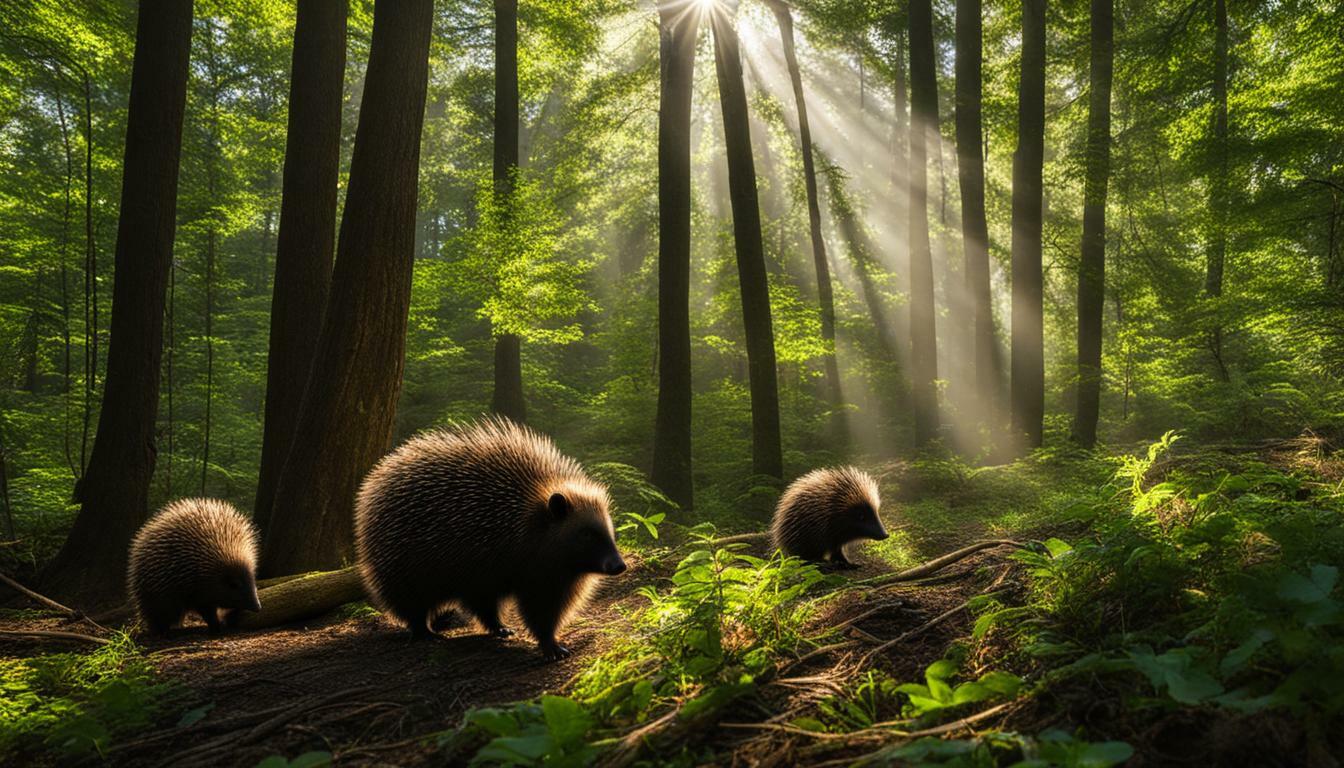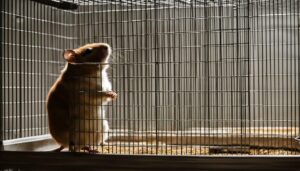If you’re wondering about the presence of porcupines in Indiana, you’ve come to the right place. Indiana, known for its diverse wildlife, has had a history of porcupines in the past.
However, their current status in the state is now rare or even extirpated. Let’s explore the distribution of porcupines in Indiana and uncover some interesting facts about their presence in the state.
Key Takeaways:
- Porcupines were once commonly found in Indiana but became rare by the mid-1800s.
- The North American porcupine is now considered extirpated in Indiana.
- Occasional sightings or stray porcupines may still occur, but they are no longer considered common in the state.
- Conservation efforts play a crucial role in protecting and potentially reintroducing porcupines in Indiana.
- Porcupines have an important ecological role in maintaining balance within Indiana’s ecosystems.
The History of Porcupines in Indiana
To understand the current status of porcupines in Indiana, it’s essential to explore their history in the state.
According to historical records, porcupines were once commonly found in Indiana, but their population significantly declined over time.
By the mid-1800s, they became rare, and today, they are considered extirpated in the state.
According to one source, porcupines were among the mammals that once roamed Indiana but were killed out.
This suggests that human activities played a significant role in the decline of porcupine populations. Habitat loss and fragmentation, as well as hunting, are believed to be the main contributing factors.
A list of mammals in Indiana includes the North American porcupine, noting that it is extirpated in the state. This means that the species is no longer naturally found in Indiana. While occasional sightings or stray porcupines may still occur, they are no longer considered common in the state.
Decline in Porcupine Population
The once thriving population of porcupines in Indiana has faced a significant decline over the years.
Historical records indicate that porcupines were once commonly found in the state, but by the mid-1800s, their numbers had already begun to dwindle.
According to various sources, including the Indiana Department of Natural Resources, the North American porcupine, which was once present in Indiana, is now considered extirpated in the state.
This means that the species is no longer naturally found here.
Factors contributing to the decline of porcupine populations in Indiana include changes in habitat and human activities.
As human development expanded and forests were cleared for agriculture and urbanization, the suitable habitat for porcupines diminished. Additionally, hunting and trapping also took a toll on their numbers.
While occasional sightings or stray porcupines may still occur in Indiana, they are now considered rare and no longer part of the state’s native wildlife.
The decline in porcupine populations serves as a reminder of the importance of habitat conservation and responsible management to protect and restore the ecological balance in Indiana’s ecosystems.
Current Status of Porcupines in Indiana
Today, porcupines are considered extirpated in the state. Habitat loss, human activities, and changes in the landscape have all contributed to the decrease in their numbers.
The extirpation of porcupines in Indiana means that they are no longer naturally found throughout the state as they once were.
This decline in population has had significant implications for the ecosystem, as porcupines play an important role in maintaining balance and biodiversity.
Extirpation of Porcupines in Indiana
Unfortunately, the extirpation of porcupines in Indiana has led to their absence from the state’s natural ecosystems.
According to multiple sources, porcupines were once commonly found in Indiana but have become rare or extirpated over time.
The decline in their population can be attributed to various factors, including changes in habitat and human activities.
Sources indicate that by the mid-1800s, porcupines were already becoming rare in Indiana. The North American porcupine, a species once found in the state, is now listed as extirpated.
Historical records suggest that porcupines were among the mammals that once roamed Indiana but, unfortunately, were hunted and killed out.
The absence of porcupines in Indiana’s natural ecosystems has had an impact on the state’s biodiversity.
These fascinating creatures, known for their quills and unique characteristics, once played a role in maintaining balance in the local ecosystems.
The extirpation of porcupines serves as a reminder of the importance of conservation efforts in protecting and potentially reintroducing species that have been lost from an area.
Porcupines in Indiana vs. Surrounding States
Understanding the presence of porcupines in Indiana becomes clearer when comparing it to the status of these fascinating creatures in surrounding states.
According to multiple sources, porcupines were once commonly found in Indiana but have become rare or extirpated in recent years.
Although occasional sightings or stray porcupines may still occur, they are no longer considered common in Indiana.
Comparing the current status of porcupines in Indiana to that of neighboring states highlights the decline in their population.
While Indiana struggles to maintain a viable porcupine presence, some states continue to have stable or even growing populations of these unique mammals.
For example, in Michigan and Wisconsin, porcupines are still relatively abundant and can be found across a wide range of habitats.
It is important to note that the decline of porcupines in Indiana is not unique. Many states in the Midwest and Northeast regions have also experienced declines in porcupine populations due to factors such as habitat loss, fragmentation, and hunting.
However, the decline in Indiana appears to have been more severe, resulting in an extirpation of these intriguing creatures from the state’s natural landscape.
Potential for Restoration
Despite the current rarity of porcupines in Indiana, there is still hope for their restoration. Conservation efforts, such as habitat restoration and protection, could potentially create suitable conditions for porcupines to return to the state.
Reintroduction programs, similar to those implemented for other endangered species, might also play a role in restoring porcupine populations in Indiana.
By understanding the status of porcupines in Indiana compared to neighboring states, we can gain insight into the challenges facing their conservation.
The decline of these unique mammals highlights the importance of preserving their habitats and addressing the threats they face.
Through collective efforts, we can work towards restoring porcupines to their once prominent presence in Indiana’s wildlife community.
The Importance of Porcupines in Ecosystems
Porcupines have a crucial role to play in the intricate web of Indiana’s ecosystems. These unique creatures, with their quills and slow-moving nature, contribute to the overall balance and health of the natural environment.
Understanding their significance can help us appreciate the importance of conserving and protecting these remarkable animals.
One of the key roles of porcupines is their impact on vegetation. They are primarily herbivorous, feeding on a variety of plants, including bark, leaves, and twigs.
In doing so, they help to shape plant communities by selectively foraging and often favoring certain plant species.
This selective feeding behavior can influence the distribution and abundance of vegetation in their habitat, ultimately shaping the composition and structure of ecosystems.
In addition to their feeding habits, porcupines also play a part in nutrient cycling. As they consume plant material, their feces contribute to the nutrient content of the soil.
By depositing their waste in different locations, porcupines aid in the redistribution of nutrients, enriching the soil and promoting the growth of new vegetation.
This process not only benefits the plants themselves but also provides resources for other organisms in the ecosystem.
Furthermore, the presence of porcupines can influence other animal species. Their burrows and dens provide shelter and nesting sites for various small mammals, birds, and insects.
These structures serve as important refuges from predators and adverse weather conditions. By creating habitats for other wildlife, porcupines contribute to biodiversity and the overall resilience of ecosystems.
While the current status of porcupines in Indiana may be limited, their ecological importance cannot be understated.
Recognizing the vital role they play in shaping vegetation, nutrient cycling, and providing habitat, it becomes clear that their conservation should be prioritized.
Efforts aimed at protecting and potentially reintroducing porcupines in Indiana can help restore their populations and ensure the continued balance and functioning of the state’s diverse ecosystems.
Threats to Porcupines in Indiana
The survival of porcupines in Indiana has been jeopardized by several threats that pose a risk to their existence.
These threats mainly revolve around changes in their habitat and human activities. One of the significant factors contributing to the decline of porcupine populations in Indiana is habitat loss and fragmentation.
As human development and infrastructure expand, the natural habitats of porcupines are being encroached upon, leading to a reduction in suitable living spaces.
Additionally, the destruction of forests and woodlands, which are crucial for porcupines, further reduces their chances of survival.
Deforestation not only diminishes the available food sources for porcupines, such as tree bark and leaves but also disrupts their nesting sites.
With their habitat fragmented and diminished, porcupines face challenges in finding adequate shelter and sustenance.
Furthermore, human activities also pose a threat to porcupines in Indiana. Illegal hunting and trapping have negatively impacted their populations over the years.
Porcupines are often killed for their quills, which are highly sought after for crafts and artwork. This illegal trade, coupled with direct hunting, has significantly contributed to the decline of porcupines in the state.
Other indirect human activities, such as vehicle collisions and urbanization, further amplify the risks faced by porcupines.
Encounters with vehicles on roadways have proven fatal for many porcupines, as they are slow-moving animals and can become disoriented by headlights.
As urban areas expand, the available habitat for porcupines continues to diminish, leaving them with limited options for survival.
In conclusion, the survival of porcupines in Indiana is under threat due to habitat loss, illegal hunting, vehicle collisions, and urbanization.
These factors have significantly reduced their populations and pushed them towards extirpation in the state.
It is crucial to address these threats through conservation efforts and habitat restoration to ensure the long-term survival of porcupines in Indiana.
Future Outlook for Porcupines in Indiana
With the implementation of effective conservation measures, there is hope for a brighter future for porcupines in Indiana.
While these fascinating creatures are currently rare or extirpated in the state, efforts are being made to restore their populations and protect their habitats.
Conservation organizations and wildlife management agencies are working together to address the factors that led to the decline of porcupines in Indiana.
This includes restoring and preserving suitable habitat, establishing protected areas, and promoting responsible land management practices.
One potential avenue for the future reintroduction of porcupines in Indiana is through captive breeding and release programs.
These programs aim to breed porcupines in controlled environments and then release them into suitable habitats where they once thrived.
This approach has been successful in other states, and it holds promise for the restoration of porcupine populations in Indiana.
While it may take time for porcupines to fully recolonize Indiana, these conservation efforts hold the potential to create a more favorable environment for these curious creatures.
By ensuring the availability of suitable habitat and protection from threats, it is possible that future generations may witness a resurgence of porcupines throughout the state.
Conclusion
The presence of porcupines in Indiana may be rare, but their historical significance and potential for conservation efforts make them an intriguing aspect of the state’s wildlife.
According to historical records, porcupines were once commonly found in Indiana but gradually became rare by the mid-1800s. Today, the North American porcupine is considered extirpated in the state.
While occasional sightings or stray porcupines may still occur, they are no longer considered a common sight in Indiana.
This decline in porcupine populations can be attributed to various factors, including changes in habitat and human activities. However, their absence should not diminish their importance in the ecosystem.
Porcupines play a vital role in maintaining balance within Indiana’s ecosystems. Their feeding habits, which include consuming bark, leaves, and twigs, contribute to the shaping of vegetation patterns and the overall health of forests.
Additionally, their specialized quills serve as protection against predators, making them a unique and fascinating species.
Although porcupines may no longer roam freely in Indiana, conservation efforts are crucial to protect and potentially reintroduce this species to the state.
By addressing the threats they face, such as habitat loss and fragmentation, it is possible to create suitable conditions for porcupines to thrive once again.
These efforts can also provide valuable insights into the broader conservation of Indiana’s wildlife.
FAQ
Are porcupines still found in Indiana?
According to the provided sources, porcupines were once commonly found in Indiana but are now rare or extirpated in the state.
When did porcupines become rare or extirpated in Indiana?
Porcupines were already becoming rare in Indiana by the mid-1800s.
Why are porcupines rare or extirpated in Indiana?
Factors such as changes in habitat and human activities contributed to the decline of porcupine populations in Indiana.
Are there still occasional sightings of porcupines in Indiana?
Although rare, occasional sightings or stray porcupines may still occur in Indiana.
What are the conservation efforts in place to protect porcupines in Indiana?
Conservation efforts are important for protecting and potentially reintroducing porcupines in Indiana to restore their populations.
How do porcupines in Indiana compare to surrounding states?
The presence and status of porcupines in Indiana may differ from that of neighboring states, providing a regional perspective on their populations.
What is the ecological importance of porcupines in Indiana’s ecosystems?
Porcupines play a vital role in maintaining balance and have ecological significance in Indiana’s ecosystems.
What are the threats faced by porcupines in Indiana?
Porcupines in Indiana face threats such as habitat loss and fragmentation, which need to be addressed for their conservation.
What is the future outlook for porcupines in Indiana?
The future outlook for porcupines in Indiana depends on conservation efforts and the possibility of reintroduction programs.
Source Links
- https://en.wikipedia.org/wiki/List_of_mammals_of_Indiana
- https://www.washtimesherald.com/community/naturally-speaking-some-indiana-mammals-making-a-comeback/article_3a99d9c2-0cdb-11ec-a0bd-d3e05051f8cf.html
- https://www.heraldtimesonline.com/story/lifestyle/2014/04/13/he-once-common-porcupine-is-no-longer-a-hoosier/47760237/




